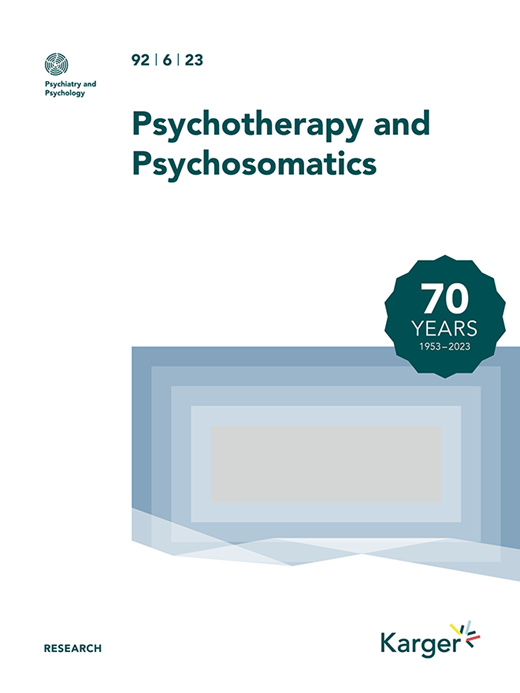数字认知行为疗法对慢性疼痛患者失眠的影响:一项随机对照试验。
IF 17.4
1区 医学
Q1 PSYCHIATRY
引用次数: 0
摘要
管理慢性疼痛是一项重大的医疗保健挑战,需要多模式的方法。合并症失眠的频繁存在及其与疼痛的双向关系使治疗复杂化。这项研究测试了在标准的慢性疼痛治疗中加入数字认知行为疗法(dCBT-I)是否能改善症状,与候补名单对照(WLC)相比。方法慢性疼痛和失眠患者随机(1:1)接受dCBT-I或WLC治疗。评估分别在基线、8周和24周后进行。主要结局是失眠严重程度(失眠严重指数;ISI)。次要结果包括睡眠和疼痛相关症状、幸福感和梦境。线性混合模型评估组间差异。结果共207例受试者(女性182例,平均年龄为51.96±12.97岁)被随机分为dCBT-I组(n=103)和WLC组(n=104)。与WLC组相比,dCBT-I组在失眠严重程度上均有显著改善(-4.36,p< 0.001;D =-1.18)和24周(-4.88,p< 0.001;d = -1.32)。疼痛相关损伤和生活控制也得到改善,有利于dCBT-I (ds=0.22-0.35)。次要结果观察到中等到较大的影响,包括白天嗜睡、疲劳和功能失调的睡眠信念(ds=0.47-1.12)。结论cbt - i可有效减轻慢性疼痛失眠患者的失眠严重程度。慢性疼痛症状的改善突出了其作为一种可扩展的、基于证据的多模式疼痛管理干预措施的潜力。本文章由计算机程序翻译,如有差异,请以英文原文为准。
The Effects of Digital Cognitive Behavioral Therapy for Insomnia in Chronic Pain: A Randomized Controlled Trial.
INTRODUCTION
Managing chronic pain is a significant healthcare challenge requiring a multimodal approach. The frequent presence of comorbid insomnia and its bidirectional relationship with pain complicates treatment. This study tested whether adding digital cognitive behavioral therapy for insomnia (dCBT-I) to standard chronic pain treatment improves symptoms compared to a waitlist control (WLC).
METHODS
Participants with chronic pain and insomnia were randomized (1:1) to dCBT-I or WLC. Assessments occurred at baseline, eight, and 24 weeks post-randomization. The primary outcome was insomnia severity (Insomnia Severity Index; ISI). Secondary outcomes included sleep- and pain-related symptoms, well-being, and dreams. Linear mixed models assessed between-group differences.
RESULTS
A total of 207 participants (182 women, mean age=51.96±12.97 years) were randomized to dCBT-I (n=103) or WLC (n=104). The dCBT-I group showed large improvements in insomnia severity versus WLC at both eight (-4.36, p<.001; d=-1.18) and 24 weeks (-4.88, p<.001; d=-1.32). Pain-related impairments and life control also improved, favoring dCBT-I (ds=0.22-0.35). Moderate-to-large effects were observed for secondary outcomes, including daytime sleepiness, fatigue, and dysfunctional sleep beliefs (ds=0.47-1.12).
CONCLUSION
dCBT-I effectively reduces insomnia severity in individuals with chronic pain and insomnia. Improvements in chronic pain symptoms highlight its potential as a scalable, evidence-based intervention for multimodal pain management.
求助全文
通过发布文献求助,成功后即可免费获取论文全文。
去求助
来源期刊

Psychotherapy and Psychosomatics
医学-精神病学
CiteScore
29.40
自引率
6.10%
发文量
46
期刊介绍:
Psychotherapy and Psychosomatics is a reputable journal that has been published since 1953. Over the years, it has gained recognition for its independence, originality, and methodological rigor. The journal has been at the forefront of research in psychosomatic medicine, psychotherapy research, and psychopharmacology, and has contributed to the development of new lines of research in these areas. It is now ranked among the world's most cited journals in the field.
As the official journal of the International College of Psychosomatic Medicine and the World Federation for Psychotherapy, Psychotherapy and Psychosomatics serves as a platform for discussing current and controversial issues and showcasing innovations in assessment and treatment. It offers a unique forum for cutting-edge thinking at the intersection of medical and behavioral sciences, catering to both practicing clinicians and researchers.
The journal is indexed in various databases and platforms such as PubMed, MEDLINE, Web of Science, Science Citation Index, Social Sciences Citation Index, Science Citation Index Expanded, BIOSIS Previews, Google Scholar, Academic Search, and Health Research Premium Collection, among others.
 求助内容:
求助内容: 应助结果提醒方式:
应助结果提醒方式:


